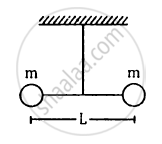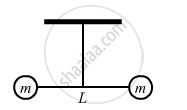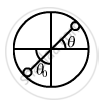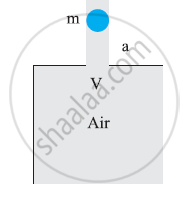Advertisements
Advertisements
Question
Two small balls, each of mass m are connected by a light rigid rod of length L. The system is suspended from its centre by a thin wire of torsional constant k. The rod is rotated about the wire through an angle θ0 and released. Find the force exerted by the rod on one of the balls as the system passes through the mean position.

Solution
It is given that the mass of both the balls is m and they are connected to each other with the help of a light rod of length L.
Moment of inertia of the two-ball system \[\left( I \right)\] is given by ,
\[I = 2m \left( \frac{L}{2} \right)^2 = \frac{m L^2}{2}\]

Torque \[\left( \tau \right)\],produced at any given position θ is given as: \[\tau\]= kθ
\[\Rightarrow\] Work done during the displacement of system from 0 to θ0 will be,
\[\frac{1}{2}I \omega^2 - 0 = \text { work done } = \frac{k \theta_0^2}{2}\]
\[ \therefore \omega^2 = \frac{k \theta_0^2}{I} = \frac{k \theta_0^2}{m L^2}\]

From the free body diagram of the rod, we can write:
\[\text {Force}, T_2 = \sqrt{\left( m \omega^2 L \right)^2 + \left( mg \right)^2}\]
\[ = \sqrt{\left( m\frac{k \theta_0^2}{m L^2} \times L \right)^2 + m^2 g^2}\]
\[ = \sqrt{\frac{k^2 \theta_0^4}{L^2} + m^2 g^2}\]
APPEARS IN
RELATED QUESTIONS
One end of a U-tube containing mercury is connected to a suction pump and the other end to the atmosphere. A small pressure difference is maintained between the two columns. Show that, when the suction pump is removed, the column of mercury in the U-tube executes simple harmonic motion.
An air chamber of volume V has a neck area of cross section a into which a ball of mass m just fits and can move up and down without any friction (Fig.14.33). Show that when the ball is pressed down a little and released, it executes SHM. Obtain an expression for the time period of oscillations assuming pressure-volume variations of air to be isothermal

Show that for a particle in linear SHM the average kinetic energy over a period of oscillation equals the average potential energy over the same period.
A circular disc of mass 10 kg is suspended by a wire attached to its centre. The wire is twisted by rotating the disc and released. The period of torsional oscillations is found to be 1.5 s. The radius of the disc is 15 cm. Determine the torsional spring constant of the wire. (Torsional spring constant α is defined by the relation J = –α θ, where J is the restoring couple and θ the angle of twist).
A body describes simple harmonic motion with an amplitude of 5 cm and a period of 0.2 s. Find the acceleration and velocity of the body when the displacement is 0 cm.
A body describes simple harmonic motion with an amplitude of 5 cm and a period of 0.2 s. Find the acceleration and velocity of the body when the displacement is 5 cm.
A body describes simple harmonic motion with an amplitude of 5 cm and a period of 0.2 s. Find the acceleration and velocity of the body when the displacement is 3 cm.
A mass M suspended from a light spring which is fixed at the upper end to rigid support oscillates in a vertical line with a period of 2 s. If the mass is increased by 20 g, then the time period of oscillation increases by 1 s. The value of M is ______.
When a mass m is connected individually to two springs S1 and S2, the oscillation frequencies are ν1 and ν2. If the same mass is attached to the two springs as shown in figure, the oscillation frequency would be ______.

One end of a V-tube containing mercury is connected to a suction pump and the other end to atmosphere. The two arms of the tube are inclined to horizontal at an angle of 45° each. A small pressure difference is created between two columns when the suction pump is removed. Will the column of mercury in V-tube execute simple harmonic motion? Neglect capillary and viscous forces. Find the time period of oscillation.
